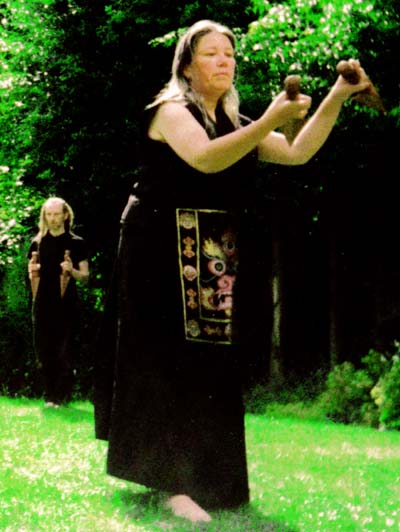| Home |

|

|
- Home
- View
- Programs
- Path
- People
- Teachings
- How to help
- Support Drala Jong
- Contact etc.
- Aro web
- Login
| Home |

|

|
| Dzogchen Gar’cham |

Dzogchen Gar’chamGar’cham exists in four modes – outer (phyi), inner (nang), secret (gSang), and most secret (yang gSang). These are known as the Dzogchen Kor-zhi (rDzogs chen sKor bZhi). The ‘outer’ form of gar’cham is the powerful colourful spectacle with which some Vajrayana practitioners will be familiar – particularly those who have spent time in the East. The inner and secret modes involve rTsa rLung and are therefore secret – but the most secret or ultimate mode of gar’cham is simply the ‘nature of movement’ in-itself as it manifests in relation to body, speech, and mind. The nature of our lives is dance. We are intrinsically self-danced dancing. This is why Chögyam Trungpa Rinpoche admonished us to ‘. . . dance with the situation.’ Whether dancing in the style of the outer gar’cham—or simply moving through the visceral scenarios which populate our existence—we need to recognise our power. If we do not see ourselves as powerful, we cannot move in a powerful way. If we are merely half-hearted escapees from the neurotic prison of deranged wilfulness, then gar’cham is impossible. Needless to say, dancing with situations would also be most-impossible. Dorje Phurba is a wrathful awareness being. Dorje Phurba wields weapons, and is, in a sense, ‘martial’ – but Gar’cham is not a martial art. As Dorje Phurba we neither attack nor defend – our being simply manifests Dorje Phurba. When we perform the dance movements of Dorje Phurba, it is possible to step outside our tired self-protective rationale into the space of being in which dualistic contrivances are cut away of themselves. The self-protective rationale is that which always wishes to blame someone or something else for our confusion. The self-protective rationale is that which seeks to avoid personal responsibility. The self-protective rationale is that which takes refuge in being ‘a poor little thing’ – a lost and confused victim of circumstances beyond his or her control. In phurba dance we relinquish the self protective rationale – we assume control and stab. When we stab, we stab the heart of our own neuroses. This is not ‘ego slaying’, in the sense in which ‘the ego’ is a thing or a part of ourselves which is ‘bad’. There is nothing to stab but illusion. bDag (Atman) is non-existent, so we—as peaceful non-violent Buddhists—are free to slay that non-existent bDag. We become stronger when we stab, rather than weaker. We are only losing ‘that which makes us small’ – our peevish need to protect bDag. ‘That which makes us small’ is only our dishonesty – our sneakiness. Tantrikas should not be sneaky people – we should not devise philosophies which validate our puerile selfishness. Tantrikas need to be accountable according to the kindness and decency of the sangha – we need to be accountable to the vajra sangha. When we dance, we are saying that we are accountable – we are members of an indestructible sangha – the gö kar chang lo’i dé (gos dKar lCang lo’i sDe). We are capable of being Dorje Phurba because we are prepared to slay our own sneakiness – our furtive desires to avoid our responsibility. We are capable of being Dorje Phurba because we rejoice in the fact that we are trapped by our commitments and therefore forced to be decent people. Our vajra brothers and sisters hold us accountable through the nature of their own practice. They have no need or impulsion to invoke guilt in us for our short-comings. They merely hold themselves accountable. There is no escape, and the dance of Dorje Phurba celebrates that fact. The sense of vajra-pride demanded by the dance of Dorje Phurba is a direct physical challenge. One cannot remain a schlemiel whilst dancing Dorje Phurba. One walks like a giant. The ground acknowledges one’s vajra nature by meeting each foot-fall totally. We are not ‘testing the ground’. We are not tentative, lest we sprain an ankle; but—as a giant—we have to treat the earth with delicacy and affection. There is little room for thought, especially when one is holding two phurbas with their silks are rattling in the wind. The whole quality of dance in terms of Dzogchen, is one of entering into the dimension of experience – through physical movement. The movements of gar’cham in themselves generate visualisation / envisionment at a visceral level. Each step lands with the heavy precision – a precision which is without doubt. It is thorough. Everything devious or furtive is destroyed. We are prepared to move thoroughly and without self-protective treachery. Our vajra brothers and sister are dancing with us, and we know what we owe them. We owe them the inspiration of our integrity, because they give us the example of their steadfastness in practice. This is why vajra dance or gar’cham is mainly performed in groups – the sense of shared commitment is highly important to Vajrayana. The kyil’khor of the vajra-sangha is massively supportive – one knows that one will be held by one’s vows through the power of shared commitment and inspiration. |
| < Prev | Next > |
|---|